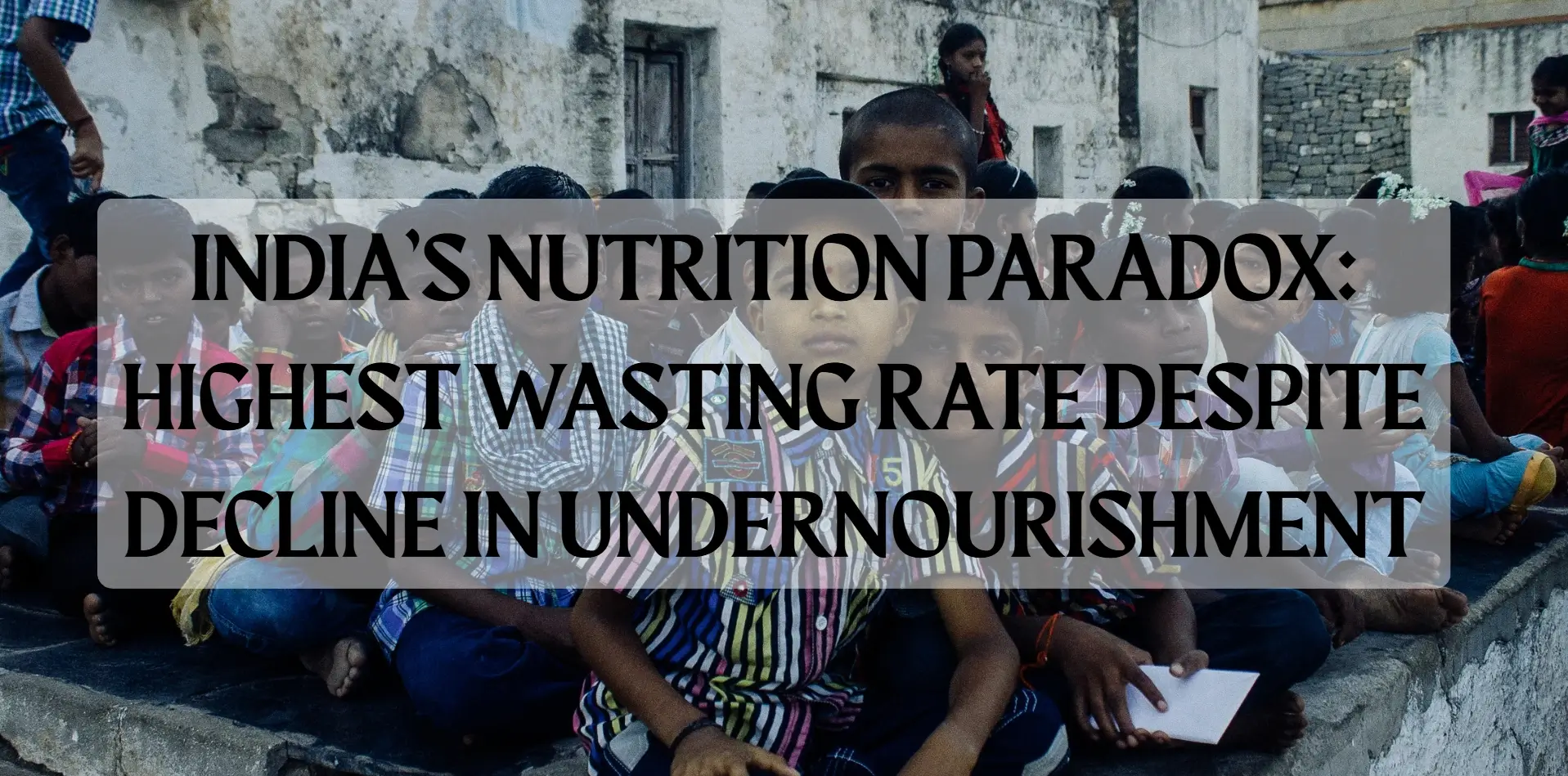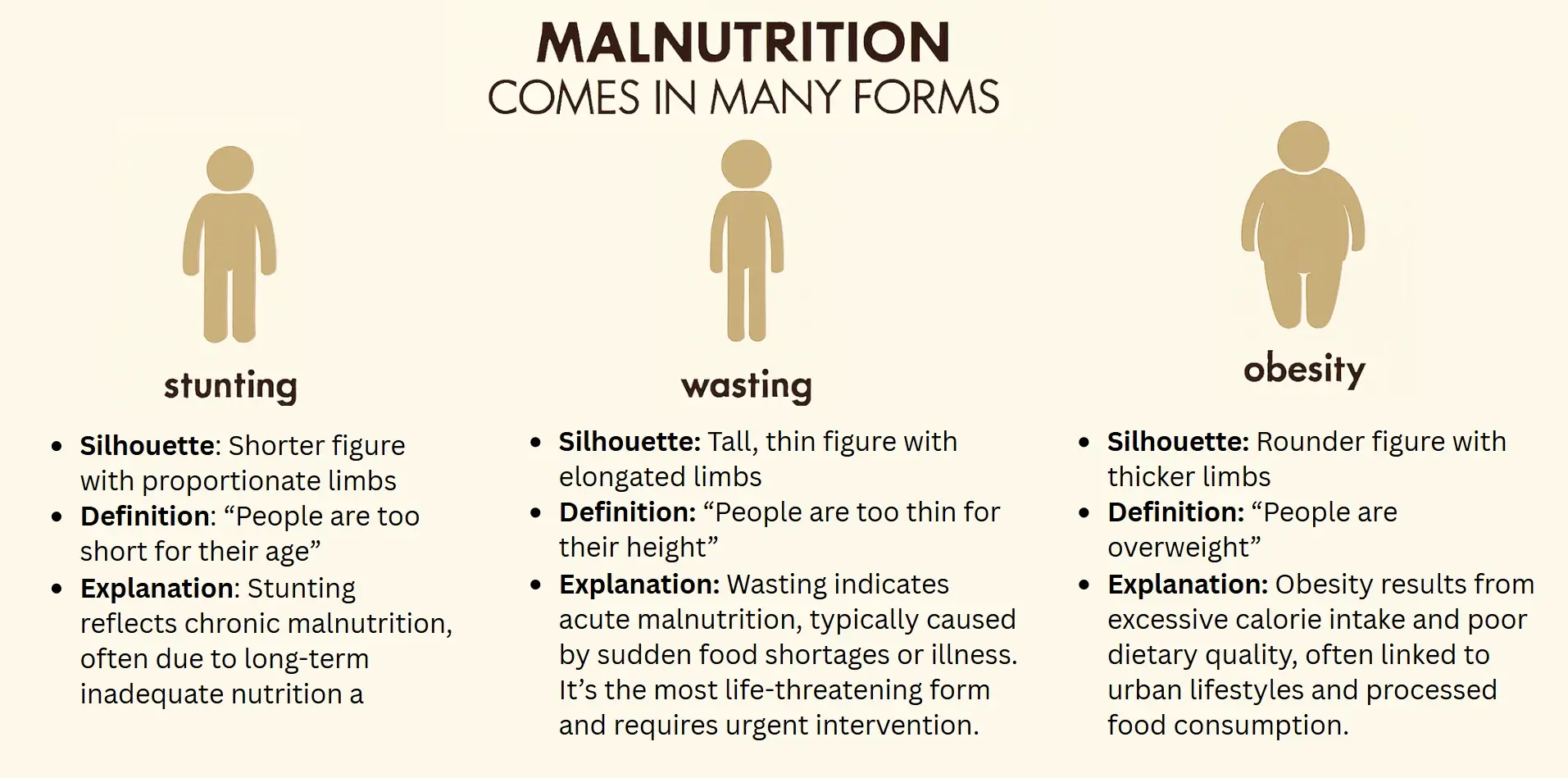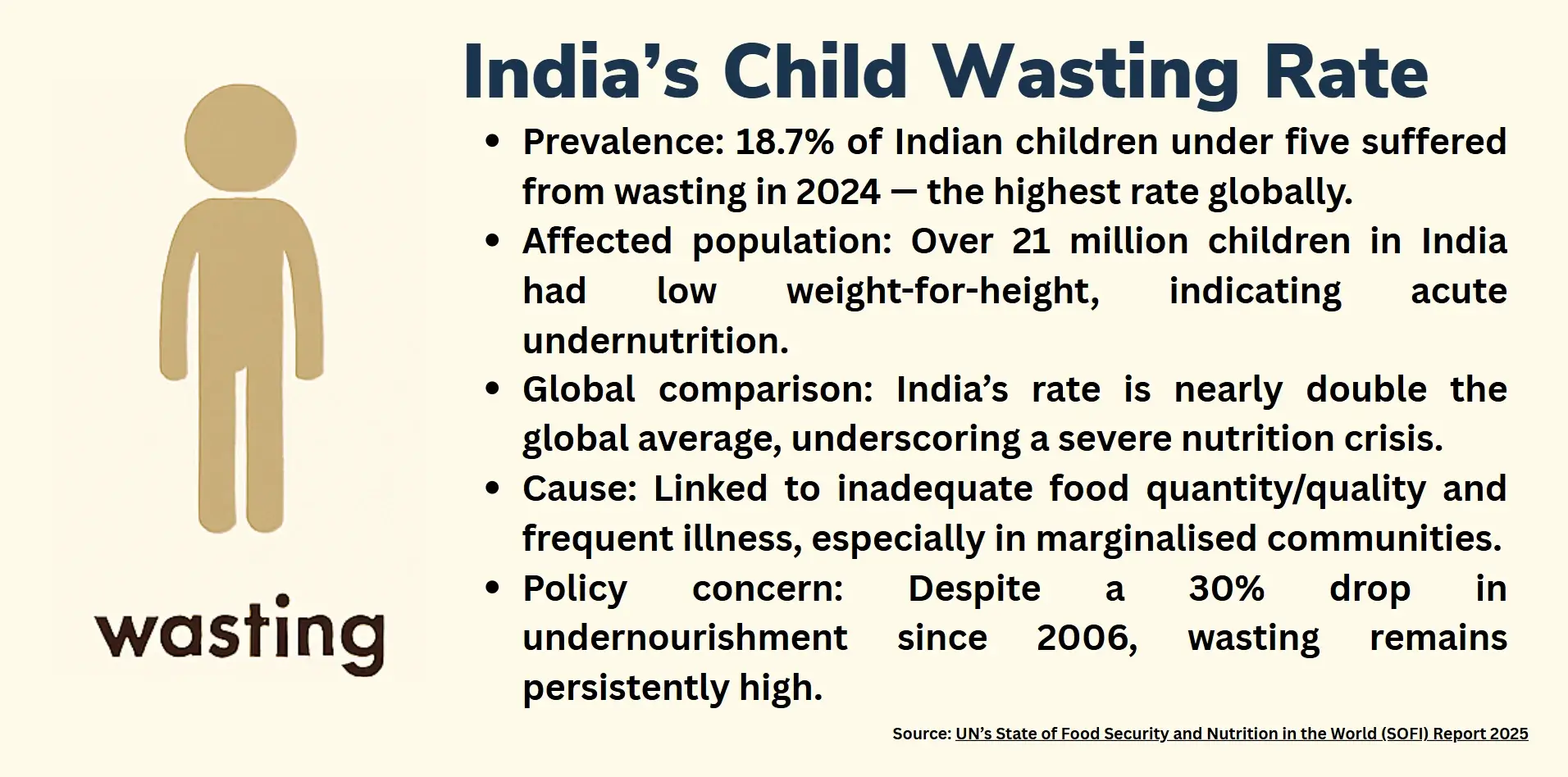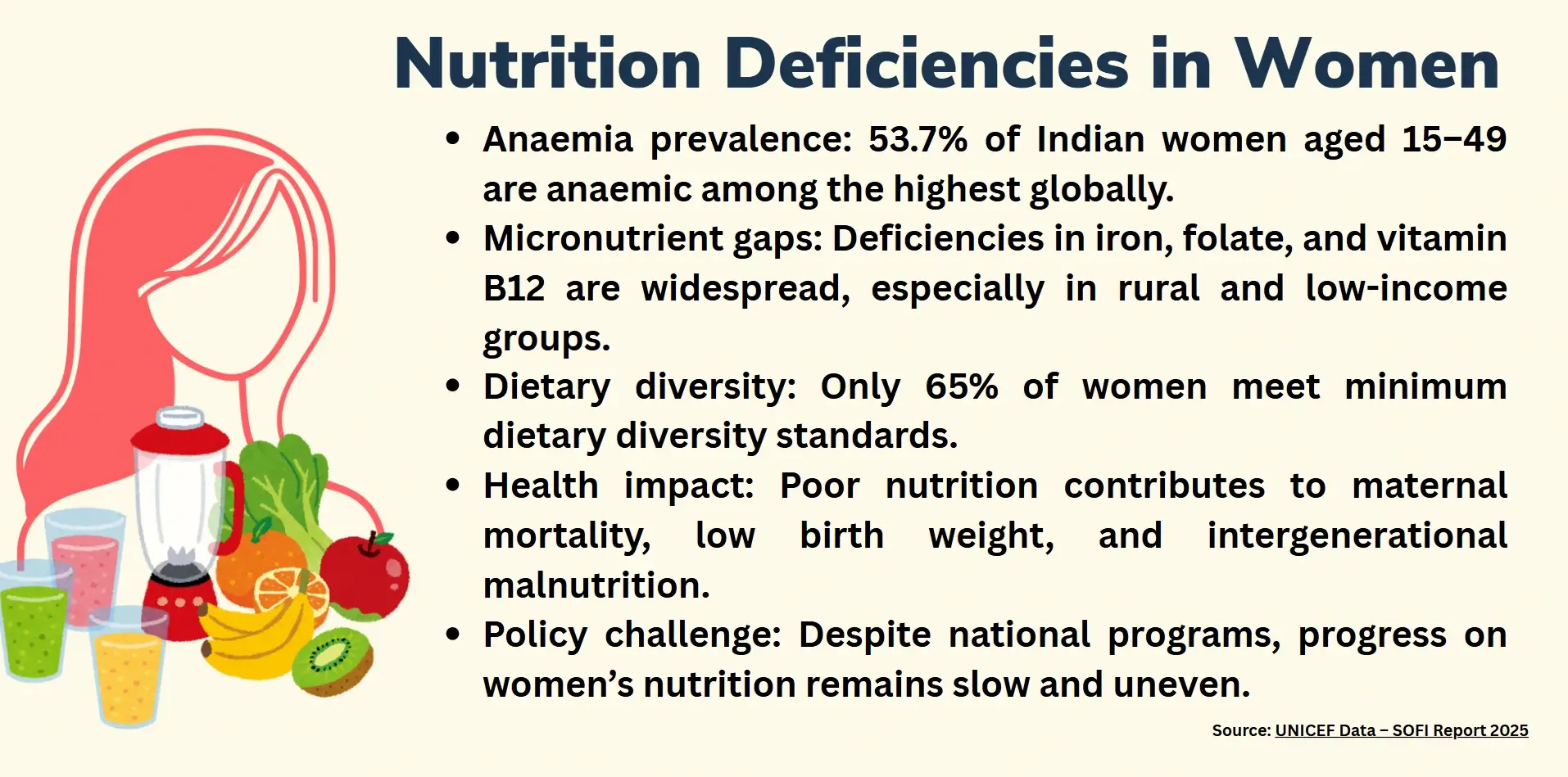India faces a nutrition paradox where undernutrition persists alongside rising rates of overnutrition, particularly in urban areas. Despite achieving food self-sufficiency, India grapples with widespread malnutrition, including child stunting, wasting, and micronutrient deficiencies, while simultaneously experiencing an increase in obesity and related health issues, according to multiple sources.Although rates of undernourishment have decreased by 30 percent, India ranks the highest in wasting linked to the unaffordability of healthy food diets and policy failure.

The situation of nutrition in India is a seesaw. The country has made great strides in the fight against hunger, with the prevalence of undernourishment having decreased by thirty percent since 2006, according to the most recent UN SOFI report for 2025. India still continues to have a larger share of stunted, underweight, and wasted children.However, with nearlyeighteen percent of children under five experiencing acute malnutrition, it has the highest rate of child wasting in the world. This paradox highlights a greater crisis that, although perhaps caloric status was better than before, access to balanced, nutrient-dense diets has experienced some distance due to the differences in availability between the rural and urban populations.Again, as of the report, nearlyforty-three percent of Indians cannot afford a healthy diet because of the high cost of food, income inequality, and inadequate nutrition infrastructure. Healthy eating is not an option formillions and more so those women and children. The results are dramatic: rampant anaemia, stunting and avoidable health problems that compromise human development and economic growth.This article discusses the structural catalysts to India's nutrition paradox, including policy gaps, food affordability, gender inequality, and regional inequality, etc. It determines that, unless India acts soon to reform on an equity basis, it will continue to suffer repeated cycles of economic growth and severe nutritional deficiency, “threatening the health and the future of its poorest citizens”.
Knowing the Metrics
The nutrition crisis in India is incomplete without debunking the most important indicators that are used in the assessment of food insecurity and malnutrition. Such measurements are not only manifestations of hunger, but also the quality and sufficiency of diets.
Defining the Indicators
Undernourishment is the deprivation of food that is typical, such as assessed by quantification during caloric deficiency over a prolonged period. It is an indication of chronic food insecurity and is commonly used to gauge national indicators of progress in the reduction of hunger. Conversely, wastingis an acute indicator of malnutrition. It happens when the child drops in weight abruptly because of sickness, malnutrition, or food deprivation. Wasting is viewed to be the most life-threatening type of malnutrition with a high risk of mortality if untreated.

Alarming Statistics of India
India has reduced undernourishment, as compared to two decades back the SOFI report shows a thirty percent decline in it. Nevertheless, there remain hundred and ninety-four million people undernourished in the country. Of greater concern, child wasting is experienced by 18.7 percent of the under-five children, which is also the worst situation in the whole world. Besides, thirty-seven million children are victims of stunting (low height-for-age), which is evidence of chronic nutritional insufficiencies. There isa 53.7 percent prevalence of anaemia in women of 15-49 years, indicating a massivedeficiency of micronutrients.
Why Wasting Needs Serious Action
Wasting, in contrast to stunting or undernourishment, indicates acute nutritional pressure, and severe wasting is commonly associated with seasonal food deficiency, infection, poor dieting habits or practices. It is a very serious issue in relation to public health since it makes people more susceptible to illness and mortality. The high rates of wasting indicate that even though food availability has increased, access to a variety of nutritious diets is still insufficient,particularly among children in low-income families.
Beyond Calories
The metrics will emphasize the need to focus more on dietary adequacy as opposed to caloric sufficiency. India does not only have a problem of feeding people, but that of nourishing people. The continued occurrence of wasting and anaemia indicates that food quantity does not always address malnutrition because alongside food quantity, one should also focus on food quality and food diversity, and affordability.
The cost of eating Healthy in India
A wide range of the Indian population cannot afford to eat healthily. Nutritious food is getting expensive to the extent that money has made healthy diets a luxury instead of aneed.

Affordability Crisis
As per the report,nearly a fourth three percent of Indians are inaccessible to healthy food. This number equates to almost600 million individuals who cannot afford such basic nutrition as fruits, vegetables, pulses, dairy, and lean meat sources of protein. Accessibility disparity is not only a financial matter, but a health crisis. In cases where foods lose their access in the various forms of nutritious foods, families therefore turn to foods that are high in energy content but lack sufficient macro- and micronutrients, i.e. a perpetuation of malnutrition and diseases reigns.
Directors of High Food Costs
There are a number of structural causes that lead to the increase in the cost of healthy food in India. The low-income levels have witnessed inflation in prices and especially in food commodities,which is much more than the level of increase in wages. Agricultural production has been affected by climate change, causing shortages in supply and market fluctuations due to climate change especially inrain-fed agriculture. Also, logistical inefficiencies, including inadequate cold storage, fragmented supply chains, end up increasing the cost of food until the end consumer gets their product. City-based markets experience overpriced retail services, whereas those based in rural areas have low coverage and distribution.
Rural-urban disparity and food disadvantage
The geographical variability of the affordability of eating healthy is very large. In urban centres, although the supply is better, the same is expensive to most informal workers and poor families. Eggs, milk, and green vegetables are the minimum nutritious foods that is rare or seasonal in rural India. This urban-rural nutrition gap contributes to inequality whereby the more financially empowered populations embrace the variety diet whereas the disadvantaged ones subsist on staple grains of little micronutrient content.
Consequences
This lack of purchasing power to buy healthy food has immediate consequences: increasing cases of anaemia, child wasting and non-communicable diseases. Unless steps are taken to bring down the prices food and to enhance its reach all it can only escalate the nutrition crisis in India, and the consequences include human development and economic resilience.
Structural Barriers of Nutrition
One of the realities that shows that the long-lasting malnutrition issue in India is not only an outcome of food shortage, it is structural issues that leave vulnerable and marginalized groups with limited access to healthy diets.
Poverty and Income Inequality
The issue of economic inequality is one of the main barriers to nutrition. Millions of Indians exist below the povertyline despite the increase in GDP and they do not even afford basic dietary diversity. The inequality in relative income is converted into food inequality: households with higher incomes eat balanced diets, whereas those who are poor eat calorie-excessive staple foods, such as rice and wheat, which lack essential vitamins and proteins. The most common occurrence of this disparity can be clearly seen in slums, tribals and informalworkers.
Poor Structure of Public Health and Nutrition
The water and sanitation system of India is underdeveloped, such that its health system cannot provide consistent nutrition services. The Anganwadicentres introduced to offer supplementary nutrition and maternal care are lacking victimization in provisions, personnel, and surveillance. The flagship nutrition mission, named POSHAN Abhiyaan, has been inconsistently implemented among states. In the absence of a strong infrastructure, nutrition programs cannot reach the people that are in the greatest need, especially children under the age of five and pregnant women.
Gender aspects of malnutrition
The problem of malnutrition in India is thoroughly gendered. The paucity of food is left to be consumed by women and girls that in most homes tends to consume food last and in small portions causing cases of low anaemia rates and underfeeding. Women have nutritional deficits made worse by cultural norms, early marriages and restricted access to reproductive healthcare. It has trans-generational consequences: mothers who were undernourished are more likely to give birth to undernourished children and the circle of deprivation continues to be completed.

Regional disparities and policy gaps
There is a great disparity in the nutrition outcomesacross different states. Kerala and Tamil Nadu present comparatively favourable indicators, but the prevalence of child wasting in states such as Bihar, Jharkhand, and Madhya Pradesh is shocking. The inequalities characterize the unequal policy implementation, resource distribution, and governance ability. Unless nationwide improvements in nutrition are approached regionally and implemented in a specific way, gains will be desultory.
Food Waste and Food Misallocation
The nutrition crisis in India is further enhanced with a paradox in that, although millions of people in this country survive on hunger or undernourishment, the country equally wastes huge volumes of food materials because of inefficiencies and practices that involve wastage habits.
Magnitude of the issue
It is estimated that India loses close to 68 million tonnes of food per year, which is sufficient to serve millions of starving citizens of the country. These ones are grains, fruits, vegetables, as well as dairy products that are wastedat different levels of production, before they reach the shelves of retail stores. The irony is bitter: food is wasted and children die of wasting and families cannot buy a good meal. Such a disjuncture exemplifies structural inefficiencies in food management and distribution.
Infrastructure and Logistics
One of the causes of food wastage is the lack of good post-harvest infrastructure. Poor cold storage, poor means of transport, and the absence of processing farms result in perishable produce getting rotten. Lack of market sometimes brings farmers into gluts in production and this leads to farmers disposing of excess crops. Urban sellers and retail chains also add to wastage by throwing edible food that could not be sold because of appearancecriteria or the expiry process.
Cultural Practices and Overconsumption
Mistakes in allocating food also occur in social traditions. Weddings, celebrations and religious feasts and ceremonies have the tendency to be lavish in terms of food preparation, even though a lot of food ends up going to waste. Domestic waste occurs because people in urban households overspend and do not know how to preserve food. Such activities are ways of a cultural loss between food availability and its nutritional accountability.
Improper allocation in the presence of Malnutrition
Some groups are incurring a lot of food waste, whereas there are acute shortages of food in others. Through public distribution systems, there is a common tendency to cater more to quantity without ensuring the quality staples that contain sufficient calories and nutrition. The bureaucratic delays or logistics may not reach the remote or marginalized community through the nutritional programs. The solution lies in food waste and misallocation management not only in efficiency, but also in justice, so that meals served are not wasted in the name of efficiency.
Policy gaps and missed targets
Although there are ambitious national efforts in the development of initiatives and global commitments, the situation with malnutrition and wasting in children in India does not improved. The country is challenged by policy gaps and lack of achievement of targets.
No progress on the Reduction of Wasting
Over the last ten years, India has not shown any significant gain in reducing child wasting on the basis ofglobal measurement of nutrition. Currently, wasting prevalence lags behind in 18.7 percent, and this is in spite of the POSHAN Abhiyaan initiated in 2018 that was successful in mitigating stunting, anaemia and low birth weight. Such failure is indicative of a more fundamental problem in program design, monitoring and execution. There are set targets, yet there has been low implementation, particularly in high-burden states.
Decentralized and underfinanced Programs
The process of nutrition interventions in India is rather scattered between ministries, which makes it structurally uncoordinated and scattered. There are duplicative schemes with little synergy used at the Ministry of Women and Child Development, Healthand Family Welfare as well as at the Ministry of Agriculture. Nutrition budgets that have been allocated are not significant and funds often remain unused. Even the best of intentions cannot bring results unless the policies are integrated in planning as well as financed adequately.
Lost opportunities on the school and the mother'sCare
Nutrition programs established in schools as in the case of the Mid-Day Meal Scheme hold potential but are of low quality and coverage. Meals tend to be inadequate and fail to match the recommended dietary. Equally, maternal health programs fail in providing pre and post-natal nutrition thus exposing women to anaemia and undernourishment.
Weak Monitoring and Data Systems
Targeted interventions require reliable data, but India has not completed its nutrition monitoring systems and they are obsolete. Surveys are few with real time tracking being very scarce. Until granular, disaggregated data are available, policymakers will have no way of finding hotspots or customizing solutions.
Conclusion
The nutrition paradox in India, which is characterized by a downward trend in undernourishment with highest child wasting in the globe, indicates that the ratio is not due to food insecurity but it demonstrates a crisis of systematic inequalities. Millions of people cannot afford or access healthy diets in spite of economic growth and large welfare schemes. There is still a degrading of progress due to structural barriers like poverty, gender inequality, poor public infrastructure and inconsistent policies. The poor distribution of food massively contributing to a wasteful problem in food even accentuates this paradoxical link that points out lack of efficiency in supply chains and social priorities.India needs to leave behind its calorie-based interventions, diversify nutrition and focus on an equitable approach to nutrition. This entails investing in local food system, enhancing affordability, fortification of maternal and child health services, and accountability (proper data system). Nutrition should not be considered as a side subject rather it should be viewed as a solid stone of human growth. That is only when healthy eating will become a right but not a luxury of every citizen of India.